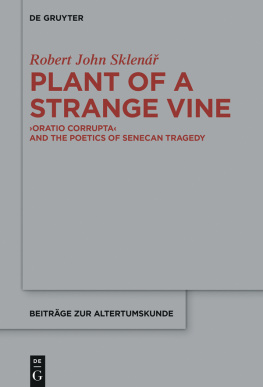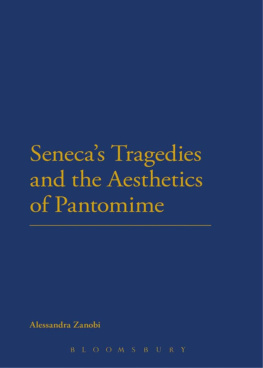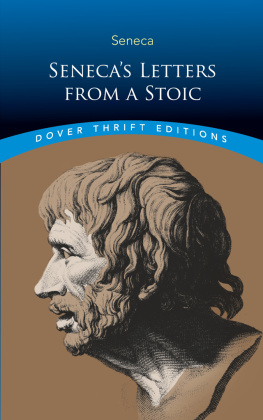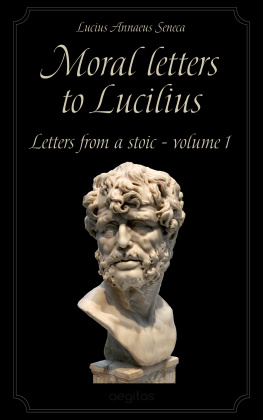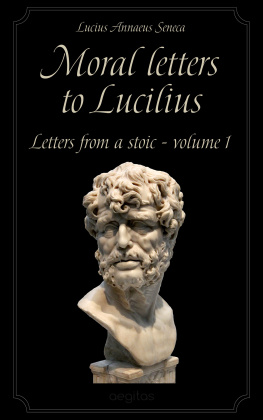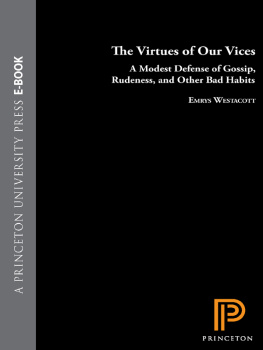Contents
Guide

Robert John Sklen
Plant of a Strange Vine
Beitrge zur Altertumskunde

Herausgegeben von Susanne Daub, Michael Erler, Dorothee Gall, Ludwig Koenen und Clemens Zintzen
Band 363

ISBN 978-3-11-051772-9
e-ISBN (PDF) 978-3-11-051974-7
e-ISBN (EPUB) 978-3-11-051894-8
ISSN 1616-0452
Library of Congress Cataloging-in-Publication Data
A CIP catalog record for this book has been applied for at the Library of Congress.
Bibliographic information published by the Deutsche Nationalbibliothek
The Deutsche Nationalbibliothek lists this publication in the Deutsche Nationalbibliografie; detailed bibliographic data are available on the Internet at http://dnb.dnb.de.
2017 Walter de Gruyter GmbH, Berlin/Boston
www.degruyter.com
Foreword
First, thanks are in order: to the University of Tennessee Humanities Center, where a fellowship during the academic year 201314 enabled me to bring this monograph close to completion; to the Classical Journal for permission to incorporate, in slightly revised form, my article Seneca, Oedipus 980 994: How Stoic a Chorus?, CJ 103.2 (200708) 183195; and to the Department of Classics at the University of Tennessee for its continued support.
The English translations from Senecas tragedies are taken from the excellent Loeb versions of Fitch, though I have modified them where necessary to reflect my interpretation. All other translations are my own unless otherwise noted; in the case of the passages from Ep . 114, however, where I have not been able to improve upon the Loeb version of Gummere I have not attempted to do so. I have also left untranslated the passages in the footnotes, as well as those shorter passages in the body of the text whose content is clear from my comments on them.
I have envisioned this monograph as a companion piece to my first book, The Taste for Nothingness: A Study of Virtus and Related Themes in Lucan s Bellum Civile (Ann Arbor 2003), which I would thereforeI admit, presumptuously request be read first. The alternative would have been to restate here much of that books discussion of Stoicism; I hope and trust my readers will agree that, as short as this monograph is, to have lengthened it by self-repetition would not have wrought an improvement.
R.J.S .
Knoxville, Kal. Dec. MMXVI
Chapter One
Letter 114 and the Poetics of Decadence
In an authoritative work published more than half a century ago, A. D. Leeman commented thus on the apparent discrepancy between Senecas literary theory and his stylistic practice: Seneca expresses his thoughts as they come to him, unorganized, spontaneous. In a longer letter, like nr. 114 , the very document in which Seneca most fully sets forth his literary theory, the lack of compositionin the modern sense of the wordbecomes painfully evident. Senecas poetry, like all Latin poetry of the Silver Age and later, is so drenched in rhetoric that it is not to be understood without recourse to rhetorical principles. By Senecas own standards, his poetic style represents a perverse use of language; is Letter 114, then, an implicit condemnation of Senecas earlier (assuming that the tragedies antedate the Letters) literary self? This explanation is of limited utility, since, as Leeman rightly observes, many of the indictments in Letter 114 can be filed against Senecas prose, not least against Letter 114 itself. Rather, Letter 114 states the Senecan poetic program in reverse: if its speculations on the relationship between language, personality, and environment are accurate, then only a poetics of the extreme could do justice to Senecas tragic vision of a doomed humanity staggering through a cosmos that is no less unhinged than its denizens.
Even through Senecas intentionally unschematized exposition, a fairly systematic catalogue of stylistic vices can be discerned. At one extreme lies a rhetorical extravagance which, depending on the times, takes the form either of bombast ( inflata explicatio ) or of precious singsong ( [explicatio] infracta et in morem cantici ducta ); at the other extreme lies excess of another sort, whichagain depending on the timesmanifests itself either in outrageous ideas ( sensus audaces ) or in phrases truncated to the point of obscurity ( abruptae sententiae ). At still other times, gaudy metaphor is in fashion ( aliqua aetas fuerit, quae translationis iure uteretur inverecunde ). All of these faults, Seneca asserts, can be explained by the Greek proverb , , which he renders into Latin as talis hominibus fuit oratio qualis vita ( Ep . 114.1): ones speech is like ones life. He then draws a curious analogy between the actions of an individual and the speech of a community: just as an individuals behavior is like a person speaking ( similis dicenti ), so the manner of speech ( genus dicendi ) reveals the character of a community ( Ep . 114.2): you can, in other words, tell a mans character from his actions, and a communitys character from its speech. Arguably, this very assertion, with its elision of the boundary between speech and action (emphasized by the assonance of dicenti and dicendi ), qualifies as a sensus audax : at the individual level, deeds have the force of words; at the civic level, the reverse is true.
After maintaining that a tawdry showiness of style ( lascivia orationis ) is indicative of a sybaritic community ( publica luxuria ), Seneca returnswith a lack of transition that invites the charge of abrupta sententia to the individual: non potest alius esse ingenio, alius animo color ( Ep . 114.3). The relationship between Animus , like Geist , inherently combines notions of soul and intellect, and in Senecas Stoic conception, the ideal state of the animus would be purely rational. To the extent that the animus is vulnerable to the emotions, i. e . is anything other than pure reason, it is diseased. Since the animus governs the entire person in any event, a diseased animus infects the ingenium perforce. Indeed, the animus is not merely the ingenium s governor: the agent construction in ab illo fingitur personifies the animus as the ingenium s artificer, just as the divine ratio is both the creator of the universe and the universe itself.
Evidence of a diseased animus , moreover, manifests itself physically:
non vides, si animus elanguit, trahi membra et pigre moveri pedes? si ille effeminatus est, in ipso incessu adparere mollitiam? si ille acer est et ferox, concitari gradum? si furit aut, quod furori simile est, irascitur, turbatum esse corporis motum nec ire, sed ferri? ( Ep . 114.3)
Do you not see that if a mans soul has grown slack, then his limbs drag and his feet move sluggishly? that if it is effeminate, then sissiness is evident in his very gait? that if it is vehement and fierce, then his step quickens? that if it is mad or (what is similar to madness) enraged, the movement of the body is in a state of upheaval, and does not proceed of its own accord, but instead is carried headlong?
Again Seneca reveals his fondness for opposite extremes: languor and effeminacy on the one hand, ferocity and fury on the other. The symptoms of these diseases of the animus can all be deduced from bodily movements because, whatever the condition of the animus , the body remains subordinate to it; when the animus is itself subordinated to irrational forces, the body is possessed by those forces and lurches out of control, as the passive verbs trahi , moveri , concitari , and ferri emphasize (especially ferri , which occurs in pointed antithesis to the active ire ). It follows that the ingenium , being at one and the same time part of the animus and the animus s handiwork, is even more susceptible to contagion: quando hoc magis accidere ingenio putas, quod totum animo permixtum est; ab illo fingitur etc .

